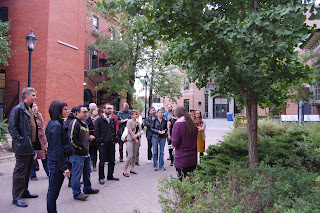 Tree identification is a cool skill to have even for the fun of it. Like pointing out the constellations, it can be a great way to impress your friends. But even more than that, being able to tell the difference between a black walnut and a green ash can give you a greater appreciation for the urban forest - and how to properly manage it.
Tree identification is a cool skill to have even for the fun of it. Like pointing out the constellations, it can be a great way to impress your friends. But even more than that, being able to tell the difference between a black walnut and a green ash can give you a greater appreciation for the urban forest - and how to properly manage it.
Just over a month ago, fellow Master of Forest Conservation student Susan Frye and I led a tree identification tour through the University of Toronto campus. The tour was part of a new initiative called Trade School Toronto, where people barter by teaching classes to community members in exchange for desirable items. We asked for fruit, recipes, tea, and jokes.
 We were excited when our course had the highest turnout of all. Susan said it “really emphasized how important trees are to the community.” And we both agreed, the enthusiasm and questions were remarkable.
We were excited when our course had the highest turnout of all. Susan said it “really emphasized how important trees are to the community.” And we both agreed, the enthusiasm and questions were remarkable.
The participants came from different levels of knowledge and skill. Some were enthusiastic amateurs, others had an interest in urban foraging, and one was even a fully-fledged botanist. The best tours are definitely the ones where the teachers have a chance to be students as well.
We started the evening with green ash trees, which are very common along Spadina Avenue. After the participants successfully identified the species using an identification key, I asked a simple question: “Does this tree seem healthy to you?” As is the case with many ash species in Toronto, there was plenty of dieback, sparse canopies, and epicormic shoots.
It did not take too long for someone to whisper, “is it the emerald ash borer?” We all gathered around and squinted until we found a tiny D-shaped exit hole. We talked about the emerald ash borer, amazed that something so small could be so devastating and stressing the need to diversify urban landscapes to avoid this kind of plight in the future.
From there we went on to identify red oak, white pine, common horse chestnut, Norway spruce and about ten other species. We saw girdled roots, galls, and stress from soil compaction, drought or mechanical damage. During the conversation we highlighted the importance of proper planting, choosing the right species, and native versus non-native.
Beyond identifying species and common stresses, we wove in stories. We talked about how the Kentucky coffee tree got its name because its seeds were roasted in place of the common morning bean; how ash trees are so ubiquitous because they replaced the elm that were lost to Dutch Elm Disease in the mid-to-late Twentieth Century. Magical or mundane, people seemed to grab onto these stories as a way to remember. And providing welcome outbursts of laughter between the lessons were the bartered jokes.
“So, how do you identify a dogwood tree?”
- “By its bark, of course.”
This post was originally published on the Local Enhancement and Appreciation of Forests (LEAF) blog.
Photos by Rebecca Launchbury

No comments:
Post a Comment